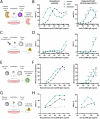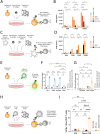Engineered human B cells targeting tumor-associated antigens exhibit antigen presentation and antibody-mediated functions
- PMID: 40808959
- PMCID: PMC12343648
- DOI: 10.3389/fimmu.2025.1621222
Engineered human B cells targeting tumor-associated antigens exhibit antigen presentation and antibody-mediated functions
Abstract
B cell engineering represents a promising therapeutic strategy that recapitulates adaptive immune functions, such as memory retention, antibody secretion and affinity maturation in murine models of viral infection. These mechanisms may be equally beneficial in oncology. Recent studies have linked endogenous anti-tumor B cell immunity to favorable prognosis across multiple malignancies. Here, we present functional validation of human B cells engineered to target tumor-associated membrane and intracellular antigens. We demonstrate that engineered B cells express therapeutically relevant membrane B cell receptors that are secreted as antibodies upon differentiation. Additionally, engineered B cells take up tumor-associated antigens and demonstrate potent antigen presentation capabilities, while their secreted antibodies activate T cell responses via immune complexes and induce tumor-directed cytotoxic responses. B cell engineering to target tumor-associated antigens may thus have utility as a novel modality for solid tumor therapy.
Keywords: B cell; antibody; antigen presentation; cell engineering; genome editing; immune complex; tertiary lymphoid structure (TLS).
Copyright © 2025 Boucher, Anderson, Hinman, Kindschuh, Fung, Wang, Klooster, Kim, Roth, Vander Oever, Khan, Zelikson, Vagima, Saribasak, Santry, Klapper, Hess, Mooney, Bublik, Laken, Barzel, Borden, Plewa, Chadbourne, Bridgen and Nahmad.
Conflict of interest statement
ABo, TW, IK, EK, BK, HS, LS, JM, CP and AMC were employed by ElevateBio. CA, RH, MK, JF, LNK, SH, DBu, HL, DBr, and ADN were employed by Tabby Therapeutics. CR, MVO, and PB were employed by Life EditTherapeutics. The remaining authors declare that the research was conducted in the absence of any commercial or financial relationships that could be construed as a potential conflict of interest.
Figures




Similar articles
-
T-bet expressing Tr1 cells driven by dietary signals dominate the small intestinal immune landscape.bioRxiv [Preprint]. 2025 Jul 4:2025.06.30.662190. doi: 10.1101/2025.06.30.662190. bioRxiv. 2025. PMID: 40747421 Free PMC article. Preprint.
-
B cell antigens: A key to optimizing CAR-T cell therapy.Int Rev Immunol. 2025 Jun 19:1-28. doi: 10.1080/08830185.2025.2515839. Online ahead of print. Int Rev Immunol. 2025. PMID: 40537997 Review.
-
Prescription of Controlled Substances: Benefits and Risks.2025 Jul 6. In: StatPearls [Internet]. Treasure Island (FL): StatPearls Publishing; 2025 Jan–. 2025 Jul 6. In: StatPearls [Internet]. Treasure Island (FL): StatPearls Publishing; 2025 Jan–. PMID: 30726003 Free Books & Documents.
-
Mouse B cells engineered to express an anti-HPV antibody elicit anti-tumor T cell responses.Front Immunol. 2025 Jul 18;16:1613879. doi: 10.3389/fimmu.2025.1613879. eCollection 2025. Front Immunol. 2025. PMID: 40755763 Free PMC article.
-
Systemic treatments for metastatic cutaneous melanoma.Cochrane Database Syst Rev. 2018 Feb 6;2(2):CD011123. doi: 10.1002/14651858.CD011123.pub2. Cochrane Database Syst Rev. 2018. PMID: 29405038 Free PMC article.
References
-
- Müller F, Taubmann J, Bucci L, Wilhelm A, Bergmann C, Völkl S, et al. CD19 CAR T-Cell therapy in autoimmune disease - A case series with fllow-up. N Engl J Me. (2024) 390:687–99., PMID: - PubMed
LinkOut - more resources
Full Text Sources

